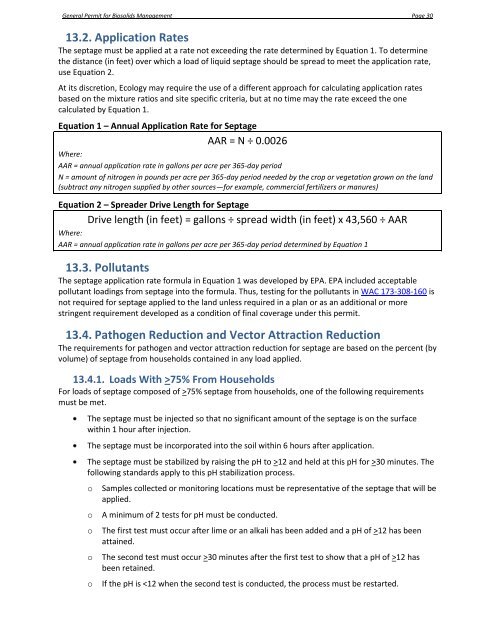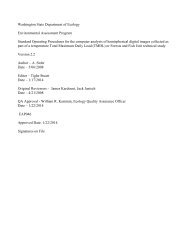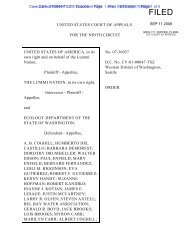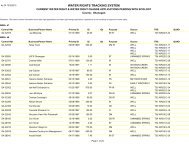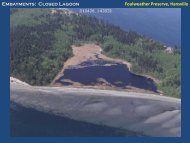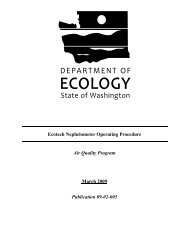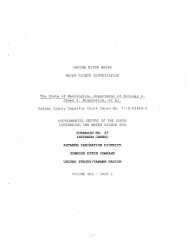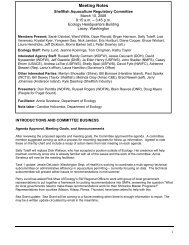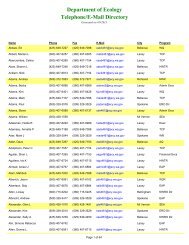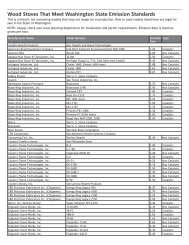General Permit for Biosolids Management - Washington State ...
General Permit for Biosolids Management - Washington State ...
General Permit for Biosolids Management - Washington State ...
You also want an ePaper? Increase the reach of your titles
YUMPU automatically turns print PDFs into web optimized ePapers that Google loves.
<strong>General</strong> <strong>Permit</strong> <strong>for</strong> <strong>Biosolids</strong> <strong>Management</strong> Page 30<br />
13.2. Application Rates<br />
The septage must be applied at a rate not exceeding the rate determined by Equation 1. To determine<br />
the distance (in feet) over which a load of liquid septage should be spread to meet the application rate,<br />
use Equation 2.<br />
At its discretion, Ecology may require the use of a different approach <strong>for</strong> calculating application rates<br />
based on the mixture ratios and site specific criteria, but at no time may the rate exceed the one<br />
calculated by Equation 1.<br />
Equation 1 – Annual Application Rate <strong>for</strong> Septage<br />
AAR = N ÷ 0.0026<br />
Where:<br />
AAR = annual application rate in gallons per acre per 365-day period<br />
N = amount of nitrogen in pounds per acre per 365-day period needed by the crop or vegetation grown on the land<br />
(subtract any nitrogen supplied by other sources—<strong>for</strong> example, commercial fertilizers or manures)<br />
Equation 2 – Spreader Drive Length <strong>for</strong> Septage<br />
Drive length (in feet) = gallons ÷ spread width (in feet) x 43,560 ÷ AAR<br />
Where:<br />
AAR = annual application rate in gallons per acre per 365-day period determined by Equation 1<br />
13.3. Pollutants<br />
The septage application rate <strong>for</strong>mula in Equation 1 was developed by EPA. EPA included acceptable<br />
pollutant loadings from septage into the <strong>for</strong>mula. Thus, testing <strong>for</strong> the pollutants in WAC 173-308-160 is<br />
not required <strong>for</strong> septage applied to the land unless required in a plan or as an additional or more<br />
stringent requirement developed as a condition of final coverage under this permit.<br />
13.4. Pathogen Reduction and Vector Attraction Reduction<br />
The requirements <strong>for</strong> pathogen and vector attraction reduction <strong>for</strong> septage are based on the percent (by<br />
volume) of septage from households contained in any load applied.<br />
13.4.1. Loads With >75% From Households<br />
For loads of septage composed of >75% septage from households, one of the following requirements<br />
must be met.<br />
The septage must be injected so that no significant amount of the septage is on the surface<br />
within 1 hour after injection.<br />
The septage must be incorporated into the soil within 6 hours after application.<br />
The septage must be stabilized by raising the pH to >12 and held at this pH <strong>for</strong> >30 minutes. The<br />
following standards apply to this pH stabilization process.<br />
o<br />
o<br />
o<br />
o<br />
o<br />
Samples collected or monitoring locations must be representative of the septage that will be<br />
applied.<br />
A minimum of 2 tests <strong>for</strong> pH must be conducted.<br />
The first test must occur after lime or an alkali has been added and a pH of >12 has been<br />
attained.<br />
The second test must occur >30 minutes after the first test to show that a pH of >12 has<br />
been retained.<br />
If the pH is


